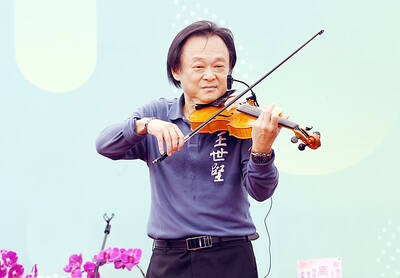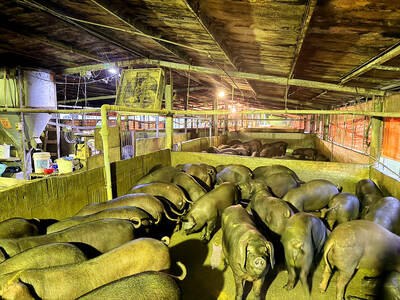More than 20 members of a native subspecies of ring-necked pheasant, commonly known as the “wailing chicken,” have been spotted by birdwatcher Huang San-ming within the Jinsha Borough of Tainan’s Sigang District. There have also been separate sightings of Formosan ring-necked pheasants perching in Beipu Borough in Jiangjun District and in Fandian Borough in the city’s Yanshuei District.
The Formosan ring-necked pheasant, Taiwan blue pheasant and mikado pheasant are the three main types of protected pheasant in Taiwan. The “wailing chicken,” or Formosan ring-necked pheasant, mostly perches in flat open fields and used to be a common sight in Taiwan. However, a combination of excessive hunting and overdevelopment has meant that these days it is rare to catch a glimpse of the bird. Huang says that Formosan ring-necked pheasants will immediately take off if they catch sight of a human or hear the wind rustling through the grass, which makes watching them extremely difficult.
(LIBERTY TIMES, TRANSLATED BY EDWARD JONES)

Photo courtesy of Huang San-ming
照片:黃三明提供
台灣特有亞種環頸雉(俗稱啼雞)在台南市西港區金砂里被鳥友黃三明發現有廿多隻出現。此外,將軍區北埔里、鹽水區飯店里也有台灣環頸雉棲息。
台灣環頸雉、藍腹鷳,和帝雉是台灣三大保育類雉雞。其中俗稱啼雞的環頸雉主要棲息在平地田野,早年常見,因濫捕加上過度開發,現在很少看到牠們蹤跡。黃三明說,因為啼雞一見人或風吹草動就跑,要看到牠們的身影不容易。
(自由時報楊金城)

A: Apart from the world’s major dictionaries, the online Dictionary.com actually picked “67” as its word of the year. B: What does “67” even mean? A: Even the dictionary wasn’t exactly sure about its meaning. The slang term’s origin might be traced to US rapper Skrilla’s song Doot Doot (67). Aren’t Taiwanese media outlets choosing the Mandarin word for 2025? B: Yeah and after hearing the song Good-for-Nothing, adapted from some catchphrases of Legislator Wang Shih-chien, I’m going to vote for the character “tsung” (hasty) from the lyrics. A: Hopefully, in the new year, we’ll be calm as the

For many people in Taiwan, childhood memories of rural life include pig pens standing beside family homes. Leftover rice, vegetable scraps and soup from daily meals were poured into buckets and fed to pigs. This practice of feeding pigs with household food waste was once a common way of life, both an economic choice and an expression of agricultural society’s deep respect for conserving resources. From a practical standpoint, pigs are omnivorous animals capable of efficiently digesting food scraps that humans can no longer eat. For rural households, food waste cost almost nothing, yet it could be converted into pork, a

Sea star wasting disease (SSWD) is a strange and serious illness affecting sea stars, or starfish. This disease causes sea stars to develop painful lesions, lose their arms, and eventually turn into a gooey, melted mess. Since it was first observed in 2013, millions of sea stars along the Pacific coast of North America have died from this __1__. Although viruses were once considered a possible cause, researchers now believe that environmental stressors and microorganisms are primarily __2__ for sea star wasting disease. One of the main environmental triggers appears to be warmer ocean water. When the water heats

1. 我是2021年受傷的。 ˇI was wounded in 2021. χ I wounded in 2021. 註:「受傷」在英文應用被動語態。 2. 全國各地成立了許多讀書會。 ˇMany reading groups have been established all over the country. χ Many reading groups have established all over the country. 註:組織由人「成立」,應使用被動語態。 3. 這些目標一定能超越。 ˇ These targets are bound to be surpassed. χ These targets are bound to surpass. 註:surpass 作「超越」解。中文原句中沒有明顯被動語態,但英文必須使用被動式 be surpassed。類似的還有 “… goals are sure to be achieved.”,不說 “… goals are sure to achieve”。 4. 他一點也不驚訝。 ˇHe was not at all surprised. χ He did not surprise at all. 註:surprise 「驚訝」應使用被動語態,中文原句中沒有明顯被動語態。 5. 我國自 2018 年起擺脫了口蹄疫。 ˇOur country has been free from foot-and-mouth disease since 2018. χ Our country has freed foot-and-mouth disease since 2018. 註: 「受傷」、「成立」、「超越」、「驚訝」及「擺脫」等在中文原句中好像並非被動語態,許多人受中文影響,在用英語表達時也用主動語態,是不對的。 Exercises A. 他一點也不適合這個職位。 He is not __________